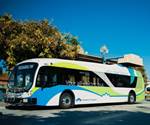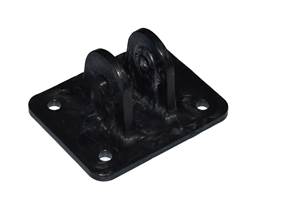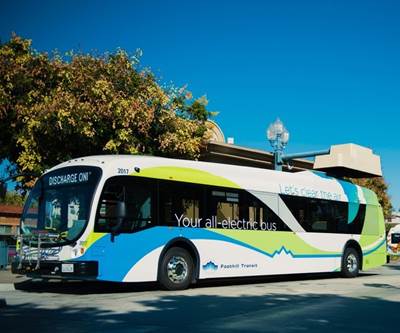Infused sandwich window frame components help double-decker buses meet weight targets
Prototype GFRP parts were evaluated by Spanish bus manufacturer Carrocerías Ayats as an initial move toward lighter, more efficient, more automated parts and processes.
Composite sandwich structures present a lightweight alternative to metal components on Spanish bus manufacturer Ayats’ double-decker buses, starting with prototype window frame cover components (bus shown is not an Ayats vehicle). Source | Getty Images
Aiming to keep up with ever-evolving European Union (EU) regulations as well as customer needs, double-decker bus designer and manufacturer (Ayats, Arbúcies, Spain) aims to strategically reduce weight on certain components of its vehicles.
Ayats, which operates in more than 20 countries and has been manufacturing vehicles since 1905, claims a history of innovation in the bus and coach industry and continues to push the boundaries of performance in its vehicle designs.
While the company has traditionally focused on steel and aluminum structures, Ayats has recently begun work in composite structures including its acquisition of the company Karbon Design, a Barcelona-based carbon fiber composite padel racket manufacturer. New to the composites space, Ayats sought technical expertise to aid in the process of transitioning Karbon Design’s composite techniques to its applications.
The company naturally turned to resin and foam distributor (Barcelona), which has supported Karbon Design for more than a decade and helped it to develop and scale up efficient in-house press molding techniques for its rackets.
Mel Composites, whose founder and CEO Eduardo Galofré came into the business after years of experience in naval architecture, is known by its customers for not only supplying materials but also contributing technical support in vacuum infusion-based composites processes. Much of the company’s work includes supply of custom-shaped foam, resins, fiber reinforcements and consumables used to infuse marine or sporting goods components. More recently, Mel Composites has begun translating its experience in these industries for infused parts in transportation and even aerospace applications.
The two selected window frame components for this project (pictured in black) connect to the rest of the aluminum frame (pictured blue), and demonstrate the feasibility of switching to composites for similar applications. Source | Mel Composites
Mel Composites’ and Ayats’ collaborative bus application project began with the analysis of the window frame cover’s four components — an evaporator drain, upper upright, lower upright and horizontal upright beams. The latter two components were selected for development in composites.
Mel Composites engineered bespoke tooling, including aluminum and tooling board molds, and developed a process for combining the two distinct parts into a single mold to increase manufacturing efficiency. The initial prototype parts were produced using resin infusion, comprising solid laminates made from glass fiber reinforcement from Gavazzi (Calolziocorte, Italy) infused with either GreenPoxy 33 from Sicomin (Châteauneuf-les-Martigues, France) or HQ800 vinyl ester from Sirca (San Dono di Massanzago, Italy), and cored with a 1.2-millimeter-thick Rohacryl recyclable, acrylate-based foam core from Evonik (Essen, Germany) sliced in-house by Mel Composites.
Ultimately, the foam sandwich composite window frame covers are said to be up to 80% lighter than a traditional rubber elastomer. According to Ayats, weight reduction in the bus contributes to greater overall efficiency of the vehicle as well as increased capacity for carrying passengers while still meeting weight requirements.
As Ayats transitions the parts from prototype into production volumes, the company is expected to adapt the process for either light resin transfer molding (RTM) or press molding.
The GFRP and foam sandwich components (pictured at left) are said to reduce weight by 80% compared to the previous rubber elastomer version (portion of this pictured right). Source | Mel Composites
Throughout this collaboration, Mel Composites has provided technical input, suggesting improvements in part design, tooling surface quality and manufacturing workflow — guiding Ayats toward a more automated, cost-effective and scalable production process.
“This project is a testament to how proven composite technologies from other sectors, like sporting goods, can be adapted to meet the unique challenges of the automotive industry,” says Mel Composites’ Galofré. “It has been a pleasure working with Carrocerías Ayats to develop components that are lightweight, low-risk and suitable for future automated production. We’re excited about the potential for further collaboration and expanded composite integration in their next-generation vehicles.”
Related Content
Revisiting the OceanGate Titan disaster
A year has passed since the tragic loss of the Titan submersible that claimed the lives of five people. What lessons have been learned from the disaster?
Read MoreHybrid process marries continuous, discontinuous composites design
9T Labs and Purdue applied Additive Fusion Technology to engineer a performance- and cost-competitive aircraft bin pin bracket made from compression-molded continuous and discontinuous CFRTP.
Read MoreCo-molding SMC with braided glass fiber demonstrates truck bed potential
Prepreg co-molding compound by IDI Composites International and A&P Technology enables new geometries and levels of strength and resiliency for automotive, mobility.
Read MoreLow-cost, efficient CFRP anisogrid lattice structures
CIRA uses patented parallel winding, dry fiber, silicone tooling and resin infusion to cut labor for lightweight, heavily loaded space applications.
Read MoreRead Next
Moving toward sustainable automotive parts manufacturing
How can the automotive supply chain prepare for future sustainability requirements? Tier 1 Kautex Textron discusses emissions reduction, design for circularity and transition to recycled/bio-based plastics.
Read MoreA clean technology for clean, zero-emissions buses
Monocoque composite body designed to support all bus loads.
Read More“Structured air” TPS safeguards composite structures
Powered by an 85% air/15% pure polyimide aerogel, Blueshift’s novel material system protects structures during transient thermal events from -200°C to beyond 2400°C for rockets, battery boxes and more.
Read More.jpg;width=70;height=70;mode=crop)












